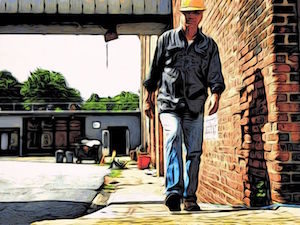Roads as History
Beware the Golden Cow

I write a lot about roads on this blog. The Yard Ramp Guy must think I'm a bit obsessed (though he’d probably phrase it differently).
The study of roads is the study of history. Countless historical events, from the outcomes of wars to international trade, and from religious expansion to the maintenance of nations: they all rely on roads.
Incan roads—not the most extensive network of ancient roads but one of the most technologically impressive—were earthquake-proof with incredibly durable suspension bridges. Roman roads have been receiving acclaim for millennia now, and many are still in use.
Which brings us to ancient Chinese roads.
Under the Qin Dynasty (circa 220 BC), Chinese road networks were considerably more extensive than their Roman contemporaries. One, the Ancient Road of Mules and Horses, was created in 214 BC by an advancing army of the Qin. The Emperor marched a half-million strong army in a straight line on one of his wars of conquest, crushing the earth in its path. They later covered the road in slate, and it remained in use for 2,000 years afterward without changing routes.

Walking up a golden ramp. Kind of.
Road maintenance was key in holding onto territory in China. Later dynasties, like the Han, went to great pains to maintain this and other roads, building hostels and post offices along their lengths. Another Qin road was immensely long, built to service border forts along a huge wall that predated the Great Wall.
My favorite ancient road of all, though, is the Stone Cattle Road. One of the ancestors of the First Qin Emperor wanted to conquer the nearby Shu kingdom to the south, over the Qinling Mountains. He had his sculptors and artisans carve five life-sized stone cows and decorate their tails and hindquarters with gold.
When the king of Shu received news of them, he asked the Qin king to send him a herd. The Qin king claimed that he would need a gallery road (built of wooden planks imbedded in the sides of cliffs) across the mountains to move the cows. The Shu king not only permitted it; he also helped fund the construction.
Yes, we know how this story develops: The first thing the Qin king brought over wasn't a herd of gold-depositing cattle. He brought an army.
_________
Quotable
Oh, Yard Ramp Guy, the road to great quotations is paved with good intentions:
“Roads are long: make them short with a good company!”
— Mehmet Murat ildan
Of a Certain Age
Or: Smelt This.
 We’ve heard of the Stone Age, the Bronze Age, and the Iron Age. And yet, we aren't commonly taught why those ages occurred in that order. Which is just too bad, since it's pretty darn interesting.
We’ve heard of the Stone Age, the Bronze Age, and the Iron Age. And yet, we aren't commonly taught why those ages occurred in that order. Which is just too bad, since it's pretty darn interesting.
The Stone Age has a simple explanation. Stone is easier to work than metal, and more common. We figured out how to use it first.
Ancient humans actually did master use of some metal during this time period— namely meteoric iron, a natural alloy of nickel and iron present in iron meteorites. We sometimes heated it but more often shaped it, by cold hammering, into tools and arrowheads; the stuff was quite difficult to work.
The ancient Inuit inhabitants of Greenland, though, used iron much more extensively than other Stone Age people. Greenland has the world's only major deposit of telluric iron, also called native iron, which is iron that occurs in its pure metal state.

Looking for the right tool to advance our evolution
Native copper, however, is found worldwide (as are native gold, silver, and platinum, all of which are of limited use for tools.) The hardest and strongest common native metal on Earth, copper proved one of the most useful.
Eventually we learned to smelt metals from ore and, around 2500 BC, learned to alloy the two together to make bronze, kicking off The Bronze Age. Tin was somewhat rare outside the British Isles, parts of China, and South Africa, so it actually ended up commanding prices higher than gold in many regions. We frequently used zinc, more common than tin, to produce brass.
Iron smelting first occurred circa 1800 BC but didn't become common until 1200 BC. Eventually, of course, iron became the metal of choice for civilization—it's just much stronger than most of the other options.
_________
Quotable
Oh, Yard Ramp Guy, and I quote:
“Stone Age. Bronze Age. Iron Age. We define entire epics of humanity by the technology they use.”
— Reed Hastings
Improving Traffic Flow
Or: It’s Zippier with a Zipper.
All traffic isn't created equal.
 For example, you've likely noticed that the morning rush hour often has greater traffic coming into the city from the suburbs and that the evening rush hour traffic clogs up the outbound lanes.
For example, you've likely noticed that the morning rush hour often has greater traffic coming into the city from the suburbs and that the evening rush hour traffic clogs up the outbound lanes.
So, we tend to have traffic moving much more slowly in one direction than the other.
Accidents and our tendency to rubberneck them also cause the traffic to bunch in one direction. (Yes, we can keep listing these reasons for a while.) Unfortunately, building new lanes for our roadways can be prohibitively expensive, and it often isn't even possible, especially where bridges are concerned.
There is a fascinating solution, though:
Road zippers are heavy vehicles that have the ability to move concrete lane dividers across a lane, widening the road for one direction of traffic, narrowing it for the other. This requires a special type of moveable barrier, with shorter segments linked together by flexible steel connectors.
The road zipper, plus new barriers, are far, far cheaper than an entirely new lane. They actually pick up the segment lines using a little conveyor system, essentially acting on the same principles as a screw or a ramp (though Jeff Mann, The Yard Ramp Guy, might think I'm stretching that definition a bit).
Road zippers can move the lane at up to a top speed of 10 mph, depending on traffic, and is much safer than trying to manage traffic with cones and lights. They're especially useful on bridges. Crews on the Golden Gate Bridge have been employing a road zipper since 2010 to manage rush hour traffic, to great effect.
Any road crew that's worked on a bridge isn't going to have particularly fond memories of dealing with bridge traffic, and the road zipper provides an effective solution. We can also use this method to speed up bridge re-decking projects, moving the barrier to protect the work zone.
Transportation authorities utilize road zippers all around the world, and they're especially popular in the United States and Australia. Many cities use them on a permanent basis, while others lease them temporarily during construction work.
Even if they weren't so useful logistically, I'd still like them: they're just plain cool.
_________
Quotable
Oh, Yard Ramp Guy, while I like your sports quotes (go, team), I tend to stay on topic:
“If you don’t know where you are going, any road will get you there.”
— Lewis Carroll
Inclined Toward Ramps
Working out the Angles

A gazillion people out there refuse to learn math after a certain age. Just absolutely refuse. In my experience, many of them frequently refuse math as much as possible. I can't say I get this, but enough people do it that, well, it's definitely a thing.
This causes a lot of problems for those of us who don't mind math—especially when we need to explain a concept that relies on that math.
As an example, let's look at describing ramp angles. Specifically, why do ramps have particular angles?
First off, we’ll choose the type of ramp. Wheelchair ramps, for instance, have an allowed ratio of 1:12. This means it's allowed to increase one inch in height for every 12 inches in length, which means about 3.58 degrees.
By comparison, the steepest road in the world has a 19-degree slope, a 35% grade (using the US system for determining road slopes). We figure this using a pretty simple equation called “rise over run.” (You just divide the rise, or the increase in height, by the run, or distance, then multiply it by 100. We're failing in our effort to avoid math, though.)
Why is the angle so much lower on wheelchair ramps? Well, we need to delve into some more math—in this case, the basic principle behind ramps:
Lifting an object always takes the same amount of work, no matter what method is used. An elevator works just as hard as you do to lift something; it's just capable of lifting more. A ramp lets you spread that work out over more time. You're still working hard, just not all at once.
 So, the reason wheelchair ramps have such an angle is to minimize the work necessary for someone to get into a building. Many yard and loading ramps have steeper angles because we often have more limited room to fit the ramp, and we’re willing to make our workers do a bit more to earn their pay. (I understand that Jeff Mann, “The” Yard Ramp Guy, has chosen to explore his own ramp angle related to mine in his blog this week. Bully for you, Jeff, and don’t hurt yourself.)
So, the reason wheelchair ramps have such an angle is to minimize the work necessary for someone to get into a building. Many yard and loading ramps have steeper angles because we often have more limited room to fit the ramp, and we’re willing to make our workers do a bit more to earn their pay. (I understand that Jeff Mann, “The” Yard Ramp Guy, has chosen to explore his own ramp angle related to mine in his blog this week. Bully for you, Jeff, and don’t hurt yourself.)
Take a look at how I described road grade and wheelchair ramps, and then see how I described the general principle behind ramps. One has more numbers than the other, but both contain essentially the exact same amount of math. I simply used words to describe it more heavily in the latter and provided examples in the former.
This really leads me to believe the problem isn't with math itself, but the way we learn it in schools. Using more real-world problems instead of pure math might really help make it more interesting. That, and actually providing the schools with enough support to do their jobs.
_________
Quotable
Top this, other Yard Ramp Guy:
“There has always been a tendency to classify children almost as a distinct species.”
— Hugh Lofting





